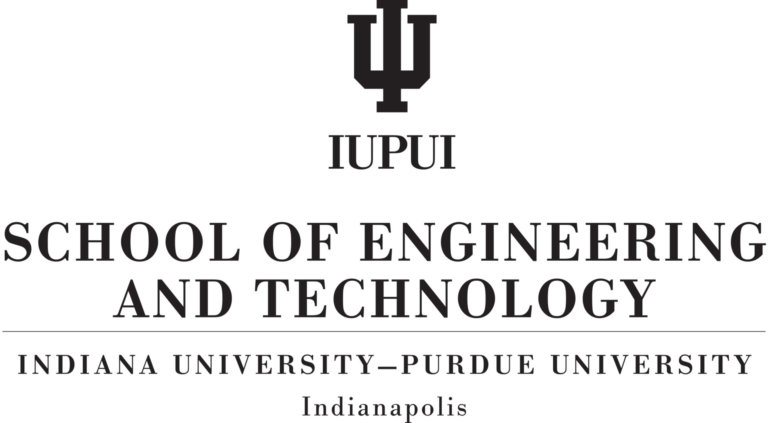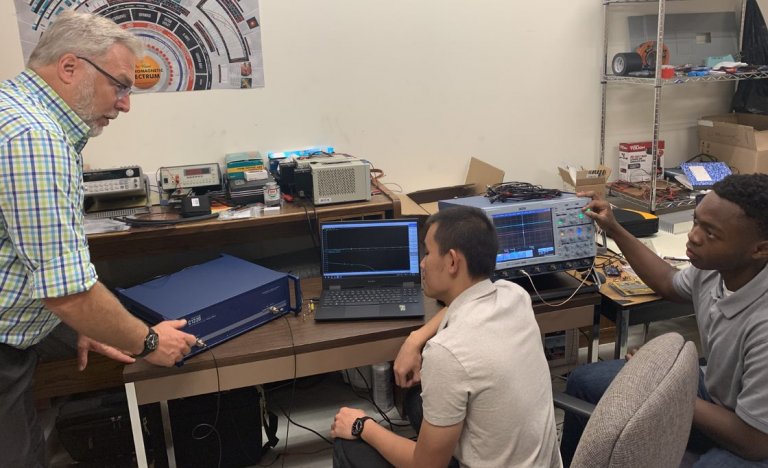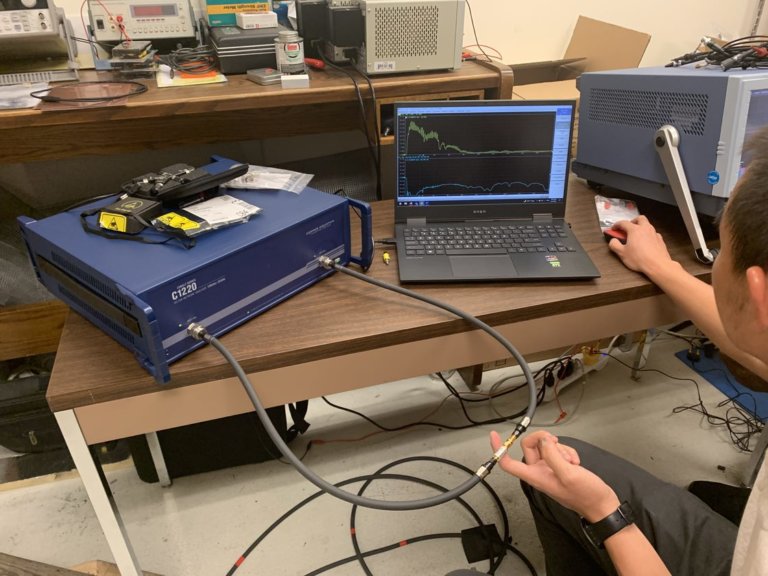
Case Study: CMT Helps Deliver Tangible RF Measurement Experience to the Next Generation of Electrical Engineers
IUPUI’s Department of Electrical and Computer Engineering (ECE) features a collection of graduate and undergraduate students, who are completing various research and design projects focusing on wireless power transfer. The addition of CMT’s C1220 2-port 20 GHz Cobalt VNA has simplified system verification and expanded the capabilities of the RF lab at IUPUI. IUPUI professor Peter Schubert has taken advantage of the price, performance, and application support of their CMT VNA to deliver tangible RF measurement experience to the next generation of electrical engineers.

Dr. Schubert has been a professor in IUPUI’s Department of Electrical and Computer Engineering (ECE) since 2011. Before that, he worked in private industry, in the automotive electronics sector as a Technical Fellow and then as a consultant for a forensic engineering firm. The throughline of his career is a passion for studying renewable energy, specifically space solar power. Wireless power transfer is one of the most challenging aspects of space solar power and has been the cornerstone of the RF work in IUPUI’s ECE department. The ECE department features a robust graduate program that attracts students from all over the world and an undergraduate program that has given many students real-world experience on their way to earning their bachelor’s degree.
Each semester the undergraduate senior design program features teams of four or five students actively working on wireless power transfer topics. Their progress and coursework have been heavily documented to facilitate the transfer of knowledge, gradually growing the lab’s capabilities over time. The ECE department is also actively working on sponsored research, where corporations working in the EE field hire students to complete undisclosed projects.

Schubert’s introduction to Copper Mountain Technologies was a serendipitous one. Living in downtown Indianapolis, he often took note of the CMT building’s lizard logo while out walking his dog. After starting his RF research, he came across advertisements from CMT and made the connection to the distinctive logo he’d seen during those walks. He then visited the office, where he was introduced to the product line and developed a continuing relationship with the company. This led to the placement of a Cobalt C1220 2-Port 20 GHz VNA in his RF lab at IUPUI in August of 2020.
As part of their work on wireless power transfer, Peter and his students make their own custom cables. This is a relatively new process for them, so verifying the performance of their cables is an important aspect of their work. This is where the need for a VNA is critical. “We could end up spending months trying to identify an error in the system without the ability to do unit testing and verify cable performance,” Professor Schubert explains. “VNAs and similar test equipment can be very costly for a small lab like ours, but CMT’s VNAs are very competitively priced,” he continues. “We were overjoyed when we were able to acquire the Cobalt C1220, it’s become a key piece of our RF laboratory”.

IUPUI’s Department of Electrical and Computer Engineering (ECE) has a standard procedure of operation that begins with an initial unit test, then a subsystem test, and concludes with full system testing. This approach minimizes the risk of mysterious anomalies near the end of the integration of a complete system. “We have learned so much about cables by having this powerful VNA,” says Peter. “The C1220 has provided us with the feedback needed to improve the quality of our students’ labor.”

Smith Charts and S-parameters measurements have been the most beneficial to their program. They also use the VNA to measure S-parameters on the patch antennas they build on campus and perform validation on components they purchase from vendors. Schubert points out that beyond the direct impact it has had on their projects, the CMT VNA provides unequaled experience to his engineering students. “Having a tool to validate hardware is of inestimable value to cement the connection between design and test in the student’s mind. The theoretical work that is the foundation of a modern engineering education is made real by the VNA.” This sentiment is echoed by his students. “We’re given the opportunity to learn with hands-on experience we would never get anywhere else,” says James Lok, a senior undergraduate student in the ECE design course. “We don’t get to work with equipment that has this high of a capability in our typical coursework.”
Having accessible test equipment enables students to dive in and quickly gain a working knowledge of various measurement processes. It’s an opportunity to apply the fundamentals learned in the classroom,” explains Adedapo Ajayi, another student in the undergraduate design course. “When I first arrived, I knew nothing about these devices. Now I can effectively operate almost everything in the lab.” Schubert believes that his students will benefit from their comprehensive educational experience as they search for opportunities in the workforce. “Undergrads who get to work on this advanced kind of stuff are way ahead of their competition in the job market,” he says.
Since the arrival of CMT’s Cobalt C1220, IUPUI’s ECE has seen a marked improvement in its research and design capabilities, which Schubert hopes will lead to further opportunities and lab developments in the future. “Successful projects will hopefully lead to more opportunities and longer research projects allowing us to go in-depth with dissertations, publications, and ultimately expand our lab’s capabilities, resulting in overall customer satisfaction.”
Beyond the measurement capabilities of their VNA, the ECE department has benefited from application support provided by CMT’s engineers, who deliver the expertise needed to help students effectively accomplish their project objectives. “CMT is at the very top of the list for customer support, they are responsive, competent, and professional,” Schubert remarks. Having the proper measurement tools has had an obvious impact on the engineering program at IUPUI, but what is the real key to the ECE department’s growth and success? According to Dr. Schubert, it’s the students. “Having undergraduate students doing graduate-level work is our secret sauce. We punch above our weight.”


